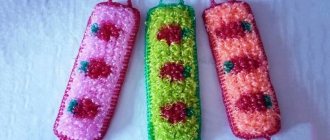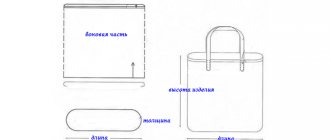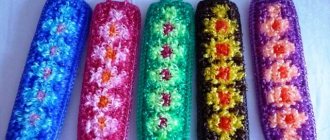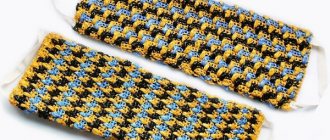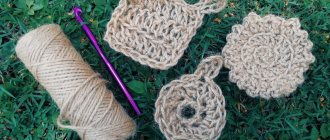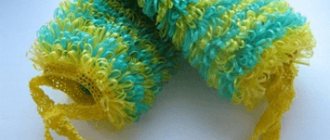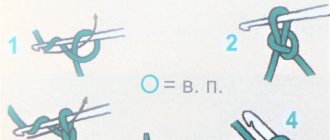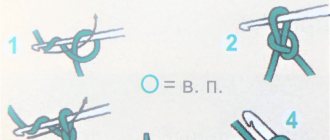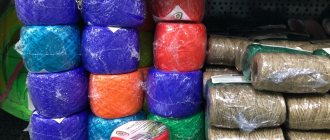Washcloth
A sponge is usually a bunch of sponge that is used for bathing. They have recently come into human use. Our ancestors simply soaped their hands or wiped themselves with a cloth. A little later they thought of covering themselves with clay and peeling it off along with the dirt. In the absence of clay, even sand was used. The first hemp washcloths began to be used only at the end of the 19th century.
as a hygiene item
The right washcloth plays an important role in proper body care. It should be thick, soft and absorbent at the same time. A properly selected sponge, while exfoliating the skin, will not scratch the body. Often, in addition to the main function of washing, washcloths help improve a person’s general condition and help overcome illness. It can be a gift for owners, newlyweds and even a baby. This care item can be bought in a store, but you can also tie a washcloth.
Advantages of a knitted washcloth:
- The hostess herself selects the desired pattern and color combination, size and shape.
- The sponge is small, so there will be little time for knitting.
- Yarn consumption is minimal; leftover threads can be used.
- Knitting patterns are simple and do not require much time.
- You can usefully spend your personal time and make the necessary thing.
Yarn for washcloths
Yarn for washcloths
Yarn for polypropylene washcloths can be of different colors. If you want, you can make such products from natural materials in the form of birch bark, rubber and others.
Remember: Washcloths made from natural materials must be changed every month. Otherwise, this personal hygiene item will turn into a real breeding ground for bacteria.
Washcloths (photo)
Today, any consumer can find a washcloth of the required shape and color. In everyday life they usually use:
- flat or tubular model with handles at the edges;
- spherical (round);
- mitten;
- heart, rectangle, voluminous sponge;
- fine mesh;
Here is a photo of several types of washcloths.
Threads for washcloths
Threads for washcloths are usually used natural or synthetic, it all depends on the preferences of the housewife. Although natural materials have a positive effect on the skin, they have a number of disadvantages. They are short-lived, susceptible to rotting and mold, and therefore require additional disinfection and drying. Synthetics do not rot at all, are easy to clean and dry well. These fibers have varying degrees of stiffness.
The quality of a knitted washcloth depends on the correct selection of threads and hook size. You can waste time and material, but knit an item that is unsuitable for washing. In many cases, you can use the hook size that is listed on the yarn label or pattern. In work, they usually use model No. 4 or No. 5. Knitting with a thinner tool looks neater, but the product itself comes out tough.
How to choose threads?
Let's take a closer look at each type of thread. Among the natural fibers suitable for knitting washcloths are:
- Hemp, made from hemp fibers.
- Jute is made from textile fiber. It makes hard products.
- Bast is rich in phytoncides, but is short-lived.
- Cotton is not very practical for washcloths.
- Wool is often used for washcloths.
- Sisal is obtained from the fibers of agave leaves and is used mainly for washcloths. It has good foaming properties and effectively cleanses the skin, providing a scrub effect.
- Flax fibers are soft, durable and dry quickly, and their qualities only increase over time. Such washcloths have numerous therapeutic and health effects on the body.
Knowing the disadvantages of natural materials, housewives still prefer synthetic fibers:
- Nylon and nylon threads, which are often used to strengthen wool. Often unwearable tights and stockings are turned into original peeling items.
- Polyethylene, ribbons of plastic bags make high-quality bath accessories.
- Viscose.
- Acrylic fibers.
- Polypropylene, the most practical and popular material for needlework.
- Rubber (rubber), today chemists have learned to produce rubber yarn, although it is rare on sale.
- Polypropylene yarn, which has increased strength. It is convenient to work with, and knitted products take good care of the body. Today, housewives have begun to combine polypropylene thread with other types of yarn, so the products come out soft and durable. Often in master classes, when knitting, pieces of foam rubber are inserted inside to give the washcloth softness.
What materials are used to make washcloths?
Cotton. Washcloths will have properties such as gentle exfoliation and improved blood circulation. Suitable for those with sensitive skin types, as well as children.
Leg-split. A feature of this material is its high strength. A product made from twine will definitely last a long time.
Polypropylene. If you need a durable washcloth that removes grease well, this material is for you.
Sisal. Washcloths for massage are knitted from it. Very durable material with a long service life. A special feature is the preservation of rigidity.
Viscose obtained from pine wood. Provides product strength.
Acrylic. This synthetic fiber is very durable, the washcloth will last a long time.
Bags. If you don’t have yarn on hand, it doesn’t matter. You can wash a flour or sugar bag and unravel it.
It is better to choose a hook depending on the diameter of the yarn used. It is better if it has a rounded end.
How to knit a washcloth with elongated loops for beginners
When creating such a model, it is enough to know the basic basics of creating “shaggy” loops. Let's look at the process step by step:
- First you need to create a chain using air loops (VP).
- After going through 3 rows with a single crochet (SC), we make a VP, then repeat the SC.
- By inserting the hook into the previous row, we create a loop.
- Picking up the thread from below with your finger, we make a large ring.
- Then, after threading the hook through the loop of the fabric, we grab the thread and pull it through. Grab the working thread again and pass it through three loops.
- We knit until we get the fabric of the desired size.
Knowing the stages of knitting elongated loops, you can start creating a bath accessory:
- We will connect a row of VPs into a circle. Its size will determine the width of the washcloth. Usually 40 loops are made.
- Having knitted 7 rows of STBN, we make elongated loops in the 8th row. They should remain on the wrong side.
- The length of the washcloth is determined by the craftswoman herself.
- We complete the work by knitting several rows of STBN, then collecting them in a circle.
- We make handles from a chain of loops. Their length is determined independently.
- The product is turned inside out and must be washed. To make the accessory soft, be sure to pour boiling water over it.
How to make a bast washcloth with handles?
The bast is the inner part of the linden bark. How to make a bast washcloth with handles?
This product can be made simply and quickly.
First method: Fold the bast threads in half and tie them lightly with a loose knot.
How to make a bast washcloth with handles? First way
Second method: Fold the bast threads in half and tie, retreating 5-7 cm from the bend.
How to make a bast washcloth with handles? Second way
Important: To make the bast sponge soft, it needs to be steamed in boiling water, just like “birch bark”.
You can sew a bast washcloth this way:
- Take the bast threads
- Place them on a flat surface and straighten them
- Sew the workpiece in a chaotic manner on a sewing machine or make several even lines
- Sew trim and handles along the edges
How to sew a bast washcloth with handles?
Crochet washcloth mitten
The bath mitten is knitted similarly to a regular mitten. The only difficulty arises when creating the thumb, but it can be omitted. For work, take threads of sisal or flax, but nylon will cause excessive rigidity. To make the product attractive, use bright yarn.
- For a large palm we create a chain of 30 VPs or 20-25 for a small one.
- We continue to work with single crochets in a circle.
- Moving to a new row, knit 1 VP.
- Having reached the desired size, connect the top of the mitten with STBN.
- Fasten the thread.
For babies, washcloths are made from flax threads by analogy. Knitting patterns greatly simplify the work.
Multi-colored propylene washcloths
It is no secret that knitting, in addition to perseverance and desire, requires certain skills from the craftswoman. We look for them in books or find them on the pages of magazines. Today, it is enough to open the Internet, ask a question in a search engine, and the required answer will appear on the monitor screen. Even if a crochet hook has just appeared in your life, with the help of the “DIY” resource you will quickly master the technique of knitting a multi-colored washcloth.
Crochet dishwasher
Every housewife knows how often she has to change her kitchen sponge. Why not knit it yourself? Only 20 g of synthetic yarn will be needed to create such an item. When knitting, you can combine the colors of the threads.
Option 1:
- Using hook number 5 we create 50 VP.
- We knit 4 rows (knit and purl) STBN. The tape comes out wide.
- Then we fold the canvas so that the smaller edge overlaps the larger one.
- Place the long end under the ring and weave the entire ribbon in a circle.
- We sew the edges.
2nd option:
- Having collected 20 VPs from a synthetic thread, we connect them into a circle.
- Let's make 10 rows of STBN. We will hide a piece of foam rubber inside.
- Let's add 10 more rows and finish the job.
Crochet washcloth video tutorials
Crocheted washcloth toy “Clean Bear” with elongated loops
The toy has eyes, a nose and ears. On one side it is shaggy, and on the other side it is smooth and has a comfortable handle.
To knit a washcloth you will need:
- polypropylene threads of three colors: any main color, black and white for the eyes
- scissors
- needle
- hook No. 2.5, hard so as not to bend
Part 1 The video should load here, please wait or refresh the page.
Part 2 The video should load here, please wait or refresh the page.
How to crochet a chicken?
To make a chicken washcloth, you need to use 2 skeins of yellow yarn, since the product is knitted with a double thread. For decoration you will need some red and black material.
- We connect a chain of 35 VPs into a circle.
- We create two rows with a double crochet (C 1/n).
- Then we knit the elongated loops on the wrong side. We wind the loose thread around the finger, insert the hook into the bottom row C 1/n, while picking up the thread from the finger, we pass the hook through the column. Throwing a thread over it, we thread the yarn through 2 loops on the hook. A fluffy loop should come out.
- Then we make a row C 1/n and alternate it with elongated rows.
- Having reached the thumb (9 rows), we begin decreasing: alternating 4 C1/n with 1 unknitted stitch.
- The row with elongated loops is left unchanged.
- Next is a row of alternating 4 C1/n with 1 unknitted stitch.
- 3 rows before the end, the elongated loops are not knitted, but the decreases do not stop. The posts close and turn the product inside out.
- The comb is formed with a red thread from the middle of the top (8-9 sc.b/n and 1 row of sc.b/n).
- The outline of the eyes is embroidered from black thread.
- For the beak, take 4 VPs and attach them to the base. The surprise for the children is ready.
Beautiful crocheted washcloths for beginners step by step: diagrams
Bath sponge
Children's washcloth
Important: Flat washcloths are knitted from jute, both knitted and crocheted. The pattern can be whatever you like.
To make such a washcloth, take birch bark, cut it into strips and tie it at one end. You will get a round ball that can be used for going to the bathhouse.
You can make a birch bark washcloth with your own hands in another way:
- Take a piece of birch bark 20cm x 20cm
- In the middle of this square, mark a strip 3cm wide
- Cut the birch bark on both sides of the mark into narrow strips
- Roll the workpiece into a tube and tie it in the middle. It turned out to be an excellent washcloth for a bath
Important: Before use, the birch bark product must be steamed by holding it in boiling water for several minutes.
- Wash the mesh after use (if you have a used mesh), and dry
- Cast on 10 mesh loops on the knitting needles and knit according to the “ribbon yarn scarf” principle. The loops should be loose and not tight
- You will get several rows of purl stitch.
- Then roll the product into a ring and secure the knitting with a hook or needle and thread
DIY washcloth made from new mesh
Kese washcloth
Kese washcloth
In the Turkish baths - hammam, they use soft washcloths in the form of mittens made from sheep's wool. You can sew a kese washcloth yourself:
- Take a piece of sheep's wool. If there is no such material, you can use any other, but soft and delicate texture
- Cut out two parts so that the finished washcloth can be easily put on your hand
- Sew these parts and trim with binding
- Make a handle - the washcloth is ready
Do-it-yourself bath washcloths made of synthetic or natural twine are knitted according to the patterns described above.
Tip: You can make a flat washcloth or a product with elongated loops, as you like.
It’s easy to make washcloths from nylon tights with your own hands:
- Cut off the top part of the tights. You only need the lower part - stockings
- Cut the workpiece into strips 3-3.5 cm wide. These strips will be the threads for knitting
- Now knit as you like - crochet or knit
Important: Products made from tights are not knitted with elongated stitches. Make a flat washcloth according to the patterns described above for creating polypropylene products.
How to crochet a strawberry?
If you want to add a bright strawberry note to your bathroom, then start knitting a “delicious” strawberry washcloth. Red and green polypropylene thread is suitable for it. If the item is intended for children's skin, take a softer yarn. For a strawberry (12 x 18 cm), a tiny piece of foam rubber is needed for filling.
- Having dialed 3 VPs, we close them in a ring, and from the center we take 6 STBN.
- Gradually add 6 loops per row.
- Let's create elongated loops in a circle. Having collected 10 rows, put the foam rubber and begin cutting the loops (two together) until the ring closes.
- Using the diagram, we will make 6 green leaves and a red flower. Carefully sew the parts to the top of the product.
- From 20 VP we will make a loop.
Crocheting washcloths with patterns and descriptions - 9 options
A hook is a fairly multifunctional tool: we use it to knit dresses, napkins, blankets, hats... But have you tried using it in combination, for example, with propylene thread? This “yarn” is inexpensive, durable, widely available (after all, it can be bought at every hardware store) and perfectly whips up soap suds. Yes, yes, an experienced needlewoman has probably already guessed: crocheting washcloths is the topic that our entire master class today is dedicated to! Stay with us and you will find out how you can quickly, inexpensively and hassle-free make an original gift or decorate your bathroom!
DIY washcloth-mitten for beginners - master class
Convenient and practical, it whips foam perfectly, thanks to its moderate softness and elasticity. Suitable even for children!
- “yarn” made of polypropylene;
- hook number 4.
Step-by-step instructions and work diagram
We dial a chain of 56 v. p. (the number of loops can be varied based on the measurements of the hand), we close them in a circle without crossing the loops. 1-2 pp.: p. without n.. 3 r.: elongated loops. We follow this work pattern to the thumb of the mitten, where it is necessary to make a hole: skip 12 stitches, and then pick up the missing 12 finger loops. We continue to knit the mitten in a circle until the little finger is covered, cut the thread and you can change the color if desired. Reduce the stitches evenly and continue until all fingers are covered. Now let's take on the thumb: knit it in a circle, 1 row - p. without n., 2 rows - elongated loops.
Let's move on to knitting the thumb. We also knit the finger in a circle, 1 row with single crochets, 1 row with elongated loops.
We tie the mitten in two rows with. without n. and make a loop.
Original loofah Diamonds
Hedgehog – Master class for beginners
Thanks to its original design, this crocheted washcloth with elongated loops is ideal for children! Considering the simplicity of its implementation, the needlewoman will cope with the task without any problems.
- “yarn” made of polypropylene;
- hook No. 3 or No. 4;
- gypsy needle;
- black yarn for decoration.
The finished hedgehog for beginners will measure 14 x 21 cm.
Description and scheme of work
We begin crocheting our washcloth with a loop, through which we will later hang the product on a hook. We dial 20 century. p. and knit one row from the second p. from the cr. = 19 s. without n.. Next we should dial p. for the 1st p. thus: 1 p. on the edge. already there, 3rd century. p., s. without n. with p. opposite sex end of the chain (close the loop), 32 v. p, conn. in a circle Now we continue to work in a circle without lifting steps: 1 and 2 pp.: 36 s. without n..
The elongated loops for the “spines” can be made either identical or of varying degrees of “elongation”. We will use the second option, since this way our hedgehog will look more realistic.
So, we introduce a hook in the previous paragraph. R. (as if you are making a simple s. without n.), extend the st., but do not finish the column. We get 2 stitches on the edge, throw on the working stitch. on the thumb of the left hand, from the same stitch we knit another 1 stitch = 3 stitches on the edge. then we knit them in one step so that they do not unravel.. 3 p.: 24 s. with extended stitches, 12 s. without n..
Knitting patterns
Using patterns for knitting washcloths in your work, you can create different models of bath accessories.
Scheme 1: Oval model
Diagram 2: Round model
Scheme 3: Elongated loops can be made not only with your finger, but also with a school ruler.


